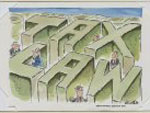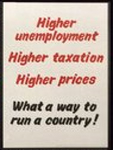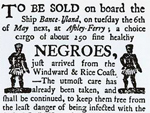Are There Instances of Raids Similar to the Boston Tea Party?

The Boston Tea Party is well documented, but are there other instances of similar raids?
The Boston Tea Party was one of many of confrontations from Charleston, South Carolina, to York, Maine, in 1773 and 1774 to prevent shipments of East India tea from entering the Colonies.
Since 1767, boycotts and non-importation agreements in opposition to the Townshend Revenue Acts had promoted political networks and personal connections across the colonies. Perhaps most importantly, regardless of their success or failure, these early resistance actions created a growing sense of common cause among colonists that began to trump local insularity and economic, social, and geographic differences.
The British underestimated extent of colonial political mobilization and the adamancy of colonial commitment to "no taxation without representation," even though colonial opposition had influenced Parliament's repeal of the Townshend Acts in 1770 (with the exception of the tax on tea). In 1773, Britain then imposed the Tea Act, in an attempt to bail out the financially-ailing British East India Tea Company. The Act allowed the company to sell directly to America, thereby bypassing competitors, circumventing British taxation, and generating sufficient corporate income to avoid bankruptcy. The Act actually lowered the price of tea in America; colonists, however, perceived it as another scheme to circumscribe what they had come to define as their rights.
Colonists acted swiftly toward nullification, generating newspapers and broadsides urging colonists once again to refuse to buy imported goods. A strongly-worded article in the Pennsylvania Packet stated,". . . revenue acts are opposite to the very idea and spirit of liberty . . . whenever Tea is swallowed, and pretty well digested, we shall have new duties imposed on other articles of commerce."
In 1773, colonists consumed an estimated 1,200,000 pounds of tea annually, much of it smuggled from Holland. It was perhaps reasonable that the East India Company believed colonial resistance to buying their tea would dissolve if they could get tea to land and offer it for sale. They engaged ships scheduled to arrive simultaneously in November 1773 in Charleston, Philadelphia, New York, and Boston and made arrangements to find American brokers for their cargo—generally merchants whose personal loyalties lay with the Crown.
All these pre-arrangements made for a poorly-kept secret: American political activists were well apprised beforehand when and where the tea ships were going to try to make port and unload their cargo and news of activities at each port was immediately sent to the others so that all their actions could be coordinated.
Nowhere in the American Colonies was the East India Company able to sell its tea. Outside of Boston, colonists, merely by persuasion or by bullying the shippers and consignees, were able to prevent the landing of the tea into port—or at least its sale. In Boston too, more than a month before the Tea Party, a body of men gathered in the street outside the store of tea merchant Richard Clarke, demanded that the proprietor vow not to receive any tea shipments. One merchant wrote that the crowd, "not receiving such an answer as they demanded, they began an attack upon the store and those within, breaking down doors, flinging about mud, &c., for about an hour, when they began to disperse, and a number of gentlemen, friends of those agents coming to their assistance, they left the store and went upon change, but met with no further insult, tho' there is much threatening."
In Lexington, the inhabitants met and resolved not to use tea of any sort, no matter where it had come from, and to show their sincerity, "they brought together every ounce contained in the town, and committed it to one common bonfire." Boston, perhaps, was unique among the other major American ports insofar as its Colonial Governor, Thomas Hutchinson, was relatively eager to demonstrate to the "troublemakers," with whom he had already had a series of confrontations, that he was the supreme authority in the affairs of the Colony of Massachusetts. This certainly contributed to why events played out in Boston as they did. (Visit this Ask a Historian response for details of events in the Boston Harbor.)
Events that happened elsewhere, after the Boston Tea Party on December 14, 1773, were also later styled tea parties, linking them to the momentous action in Boston. Like the Boston Tea Party, they were efforts to reject tea shipments and to enforce a boycott of the East India Company's product.
On December 3, 1773, Alexander Curling, the captain of the London, had brought a cargo of tea to port in Charleston, but its consignees had refused delivery. On December 22, a week after the Boston Tea Party, a committee of colonists told Curling to return the tea to England, but the captain balked. The customs collector then had the 257 tea chests seized for non-payment of customs duties, unloaded, and stored in a locked room in the Exchange building (they were sold in 1776, with the proceeds going to finance the Revolutionary cause).
In late June of 1774, Captain Richard Maitland brought tea into Charleston harbor aboard the British ship Magna Carta. When local officials confronted him, he told them he would return the tea to England, but local men boarded the ship after hearing rumors that he intended to sell the tea. Captain Maitland took refuge on board the 100-gun British man-of-war HMS Britannia. That ship landed seven chests of tea in Charleston on November 3, but local officials ordered the merchant consignees to dump it in the Cooper River "as an Oblation to Neptune," and in order to avoid mob violence, they did.
On Christmas Day, 1773, three days after the tea from the London was seized in Charleston, the British ship Polly, laden with 698 cases of tea, sailed up the Delaware River toward Philadelphia and landed at Chester, Pennsylvania. Its captain, Samuel Ayres, was escorted into the city where he was met by a committee of hard men representing a mass meeting of perhaps 8,000 citizens who told him that he had better return the tea to England. They may have offered to pay some of his expenses and may also have drawn his attention to a broadside that promised to tar and feather him if he attempted to unload the tea. The broadside promised the same treatment to any river pilot who tried to bring the ship into Philadelphia and to any consignee who attempted to accept the shipment. The Polly sailed away without putting into port.
On December 10, just before the Boston Tea Party, the brig William, which had been headed to Boston along with the other tea-laden ships, wrecked off Provincetown. The ship's captain, Joseph Loring, off-loaded the 58 chests of its tea cargo before abandoning the ship, and sent it along to Boston for safe keeping, by agreement with the consignee, the son of Boston tea merchant Richard Clarke. Jonathan Clarke, who had rushed to Wellfleet to make the transfer, allowed his cousin there, David Greenough, to have two cases to sell on Cape Cod, a small amount of which he sold to a Colonel Willard Knowles, who also happened to be in charge of the town of Eastham's stock of ammunition. When their neighbors discovered what had happened, both men were brought into disrepute. Action erupted on March 7, 1774, when about 80 people unsuccessfully tried to "wrest the Towns Ammunition out of the Hands of Col. Knowles." Knowles's neighbors eventually forgave him, and Greenough apparently destroyed the rest of the tea from his two cases.
That left 56 chests of the William's cargo that had been sent to Boston. The Sons of Liberty quickly discovered where it was being kept and raided the place, but found only half of it, 28 cases, which they smashed and emptied into the harbor.
On March 7, 1774, as Colonel Knowles confronted his Eastham neighbors, and a day that Colonial Governor Thomas Hutchinson had proclaimed a day of public fasting, a band of men, evidently believing they had located some of the William's tea that remained, entered the Boston shop of tea merchant Davison, Newman, & Company (whose tea had been destroyed in the Boston Tea Party) and took 16 chests of tea down to the harbor, broke them open, and dumped the contents into the water. This has been referred to as the second Boston Tea Party.
Again, on the same day, March 7, 1774, King George III sent a message to the British Parliament, asking it to exact retribution for the destruction of tea in Boston. Parliament obliged him by passing the Boston Port Act, which would close the port to commerce, beginning on June 1.
On April 18, 1774, the Nancy, commanded by Captain Benjamin Lockyer, having been blown far off course by storms, finally anchored at Sandy Hook, "having on board something worse than a Jonah, which, after being long tossed in the tempestuous ocean, it is hoped, like him, will be thrown back upon the place from whence it came," according to the New York Journal. Its cargo consisted of 698 chests of tea. The consignees sent a note to him, saying they would not accept the tea because it would "expose so considerable a property to inevitable destruction." They advised Lockyer that, "for the safety of your cargo, your vessel, and your persons, it will be most prudent for you to return" to England. Members of the New York chapter of the Sons of Liberty took charge of the Nancy at Sandy Hook, and prevented its crew from deserting the ship, and escorted Lockyer into New York City, where he agreed to return to England with the tea and began procuring supplies to do so.
Meanwhile, on April 22, the ship London (which had been in Charleston in December) arrived, now under the command of a Captain Chambers. Although Chambers protested that he had no tea aboard, the Sons of Liberty had received word from Philadelphia that he was smuggling 18 chests, for his own profit, hidden among the ship's blankets. Chambers was taken into custody and members of the Sons of Liberty searched the ship, discovered the tea chests, broke them open, dumped the tea into the river, and brought the busted chests back to the city, where they were used to ignite bonfires in the streets. Chambers was threatened with his life, but he managed to escape, and made his way to the Nancy. A few days later, the ship sailed back to England with both Lockyer and Chambers aboard.
One night in late January, 1774, Princeton College students from all the colonies broke into the College's storeroom, and then, as described by student Charles Beatty, "gathered all the steward's winter store of tea and having made a fire on the campus we there burned near a dozen pound, tolled the bell, and made many spirited resolves." They also made an effigy of Massachusetts Governor Hutchinson, tied a tea canister around its neck, and burned it in front of Nassau Hall. Students subsequently continued their agitations, including paying nocturnal visits in groups of 40 "drest in white," to local townspeople rumored to be tea drinkers, seizing their stock of tea, and burning it.
On May 23, 1774, the local chapter of the Sons of Liberty, having heard that the Port of Boston was to be closed, and having passed a series of "resolves" against buying, selling, or drinking tea shipped from England, heard that the brig Geddes (which was possibly owned by the local customs inspector, William Geddes, who was also a merchant) had put into port in Chestertown with tea in its cargo. They boarded the brig by force and dumped its tea into the Chester River.
Some of the facts in this instance are a little spare—such as who owned the tea and where it had come from. Nevertheless, the city of Chestertown stages an enthusiastic reenactment of the "Chestertown Tea Party" every Memorial Day weekend.
In the summer of 1774, Thomas Charles Williams, the London representative of an Annapolis merchant firm, tried to smuggle tea across the Atlantic into Annapolis by disguising nearly a ton of it in 17 packages labeled as linen, and loading it among the rest of the cargo on the brig Peggy Stewart. The captain of the brig, Richard Jackson, only discovered the true nature of the "linen" while at sea. A few years before, an Annapolis precedent had been set when its customs officer refused to allow any ships to unload any portion of their cargo until the tax on all of it had been paid. This now alarmed Captain Jackson because most of the rest of the Peggy Stewart's cargo consisted of 53 indentured servants.
The ship reached Annapolis on October 14, 1774, and Williams's business partners decided they wanted nothing to do with his attempt at smuggling. They could not think of risking the lives of the indentured servants by sending the ship back across the Atlantic during the storm season which had just begun. They paid the customs tax due and quickly got the human cargo ashore, leaving the tea onboard. The presence of tea aboard ship had inflamed public opinion in Annapolis. Williams and his business partners were threatened with lynching; their store and their homes, with destruction. To avoid that, the business partners offered to burn the Peggy Stewart, which they owned, along with its cargo, which they did, on the night of October 19. This came to be called the Annapolis Tea Party. The city of Annapolis marks this each year with a ceremony.
On September 15, 1774, the sloop Cynthia sailed into harbor at York, Maine, from Newfoundland with a cargo that included 150 pounds of tea for its owner, local judge and Tory sympathizer, Jonathan Sayward. The local Sons of Liberty noted its arrival and called a town meeting on September 23. Meeting participants voted to seize the tea, which was done against the objections of the ship's captain, Sayward's nephew, James Donnell. The tea was placed in a storeroom, "until further Discovery could be made." That night, "a Number of Pickwacket Indians" (so it was said) broke into the storeroom and made off with the tea. Two days later, however, it was mysteriously returned, so perhaps Sayward was able to drink his tea after all, without having to pay customs duty on it (because it had been stolen). This was later called the York Tea Party.
In the summer of 1774, the captain of the small ship, Greyhound, loaded with East India Company tea, was reluctant to try to unload his shipment in Philadelphia, so just before the Delaware Bay, he put into Cohansey Creek, and anchored at the little hamlet of Greenwich, New Jersey. There he unloaded his cargo, and it was put into the cellar of a Loyalist, Daniel Bowen, who intended to have it eventually carried overland into Philadelphia and to sell it there.
On the night of December 22, 1774, after planning in secret for several months, 40 locals dressed as Indians broke into Bowen's house, carried the cases of tea into a field, dumped the tea in a large pile, and set it all on fire. Those who participated in this tea party were arrested but were not convicted because the jury was in complete sympathy with them.
Benjamin W. Labaree, "Boston Tea Party: American Revolution,"United States at War: Understanding Conflict and Society, ABC-CLIO, January 7, 2009, http://www.usatwar.abc-clio.com (accessed January 2009).
T.H. Breen, The Marketplace of Revolution (Oxford: Oxford University Press, 2004), 294331.
Francis Samuel Drake, Tea Leaves: Being a Collection of Letters and Documents Relating to the Shipment of Tea to the American Colonies in the Year 1773, by the East India Tea Company (Boston: A. O. Crane, 1884), 8485, 256259.
John R. Alden, A History of the American Revolution (New York: Da Capo Press, 1989), 138140.
Ruth M. Miller and Ann Taylor Andrus, Charleston's Old Exchange Building: A Witness to American History (Charleston: The History Press, 2005), 2628.
David Lee Russell, The American Revolution in the Southern Colonies (Jefferson, N.C.: McFarland, 2000), 46.
Edward S. Gifford, Jr, The American Revolution in the Delaware Valle (Philadelphia: Pennsylvania Society of Sons of the Revolution, 1976), 21-22.
Isaac Q. Leake, Memoir of the Life and Times of General John Lamb (Albany: Joel Munsell, 1850), 8083.
Albert Ulmann, "The Tea Party New York Had," The New York Times, January 21, 1899, BR38.
Theresa Barbo, "A Bitter Wellfleet Tea Party," in True Accounts of Yankee Ingenuity and Grit from the Cape Cod Voice (Charleston: The History Press, 2007), 2326.
Edwin Mark Norris, The Story of Princeton (Boston: Little, Brown, and Company, 1917) 7879.
Willis Rudy, The Campus and a Nation in Crisis: From the American Revolution to Vietnam (Madison, N.J.: Fairleigh Dickinson University Press, 1996) 1012.
Charles Edward Banks, The History of York, Maine, Volume 1 (Boston: Calkins Press, 1931), 386.
George Ernst, New England Miniature: A History of York, Maine (Freeport, ME.: Bond Wheelwright Company, 1961), 76.
"The Tea Party at York Maine," http://imaginemaine.com/Tea_Party.html (accessed January 2009).
Website of the annual Chestertown Tea Party Festival, http://www.chestertownteaparty.com/ (accessed January 2009).


